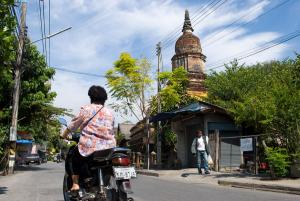Chiang Mai was founded in 1296, which, if you stop and think about it, was a really long time ago. Even though we're rapidly losing the city to shopping centers, expensive condominiums and pickup trucks that don't fit on the road, there are still a lot of ancient relics in the dark corners of this weird little town. You may have to get a little dirty to find them, so rent a motorbike, put on your history pants and let's have an adventure!
THE SECRET MOAT AND THE FIFTH CORNER
 In 1776, the Burmese were kicked out of Chiang Mai after 200 years of occupation. Decades of war left the city such a mess that it was empty when the Thais retook it, and for the next twenty years Chiang Mai was totally abandoned. When Kawila, the king of Lampang, resettled the city he rebuilt the moat and old city walls (the crumbling sections you see today are from this period), but he also built a second wall to encompass Chiang Mai's expanding suburbs towards the river. You've probably never seen this wall, but it's still there behind dilapidated houses, polluted streams and even running through the Night Bazaar.
In 1776, the Burmese were kicked out of Chiang Mai after 200 years of occupation. Decades of war left the city such a mess that it was empty when the Thais retook it, and for the next twenty years Chiang Mai was totally abandoned. When Kawila, the king of Lampang, resettled the city he rebuilt the moat and old city walls (the crumbling sections you see today are from this period), but he also built a second wall to encompass Chiang Mai's expanding suburbs towards the river. You've probably never seen this wall, but it's still there behind dilapidated houses, polluted streams and even running through the Night Bazaar.
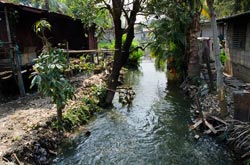 The best-preserved part is Jaeng Thippanet (แจ่ง = bastion, the other corners are called the same), rising above a run down neighborhood just south of the Old City. It's the same size and shape as the other corners, but lived-on and completely unrestored. To find it, head towards Airport Plaza from the southwest corner of the moat and park in front of the first 7-11 on the left - you can just barely see it from the road, through the ratchapruek trees in a poorly-maintained park, but to get there you have to walk down the alleyway next to the 7-11. Cross the stream (that's the second moat, by the way) and walk up the wall to find the bastion.
The best-preserved part is Jaeng Thippanet (แจ่ง = bastion, the other corners are called the same), rising above a run down neighborhood just south of the Old City. It's the same size and shape as the other corners, but lived-on and completely unrestored. To find it, head towards Airport Plaza from the southwest corner of the moat and park in front of the first 7-11 on the left - you can just barely see it from the road, through the ratchapruek trees in a poorly-maintained park, but to get there you have to walk down the alleyway next to the 7-11. Cross the stream (that's the second moat, by the way) and walk up the wall to find the bastion.
The second moat actually continues on all the way to the northeast corner of the Old City, but the only remaining parts of the wall are near the Night Bazaar on Kamphaeng Din (which, interestingly enough, means "earthen wall").
ABANDONED TEMPLES
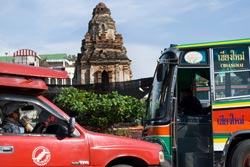 "Chedi" is the Thai word for stupa and every temple in Thailand has at least one. Thais are very strict about not demolishing them, which means that there are dozens of ancient chedi scattered throughout the city. Many are so old that no one remembers their name or when they were built, though the CMU Fine Arts Department has erected a few plaques in English and Thai. Most of them are down back alleys north, south and inside the Old City and some have even been built into houses. There are even a few deep into the forest - the 700 year old chedi of San Ku, for instance, is down an unmarked trail about 10km past Wat Doi Suthep.
"Chedi" is the Thai word for stupa and every temple in Thailand has at least one. Thais are very strict about not demolishing them, which means that there are dozens of ancient chedi scattered throughout the city. Many are so old that no one remembers their name or when they were built, though the CMU Fine Arts Department has erected a few plaques in English and Thai. Most of them are down back alleys north, south and inside the Old City and some have even been built into houses. There are even a few deep into the forest - the 700 year old chedi of San Ku, for instance, is down an unmarked trail about 10km past Wat Doi Suthep.
RUINS BEHIND WAT UMONG
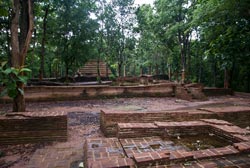 Head down to Wat Umong, walk up the stairs to the chedi and find the emaciated Buddha statue - nearby you'll find signs cryptically marked "zoo" and an iron gate, which leads to the forest behind the temple. This is technically a wildlife conservation area or something, as attested by the herds of semi-tame banteng (big cows) and different types of small deer running around, but among it all there are several partially restored temples from long, long ago. There's no plaque in place yet, unfortunately.
Head down to Wat Umong, walk up the stairs to the chedi and find the emaciated Buddha statue - nearby you'll find signs cryptically marked "zoo" and an iron gate, which leads to the forest behind the temple. This is technically a wildlife conservation area or something, as attested by the herds of semi-tame banteng (big cows) and different types of small deer running around, but among it all there are several partially restored temples from long, long ago. There's no plaque in place yet, unfortunately.
ANCIENT LAWA CITIES
Hundreds of years before Chiang Mai was founded, Lawa people lived here in a collection of small, walled towns (the Lawa are still around, way up in the hills). One was simply torn down and replaced by the Old City, but there are at least two others that can still be spotted with a sharp eye and a satellite map.
Wiang Suan Dok, as you might guess, was on the current site of Wat Suan Dok on Suthep road. Looking at a satellite image you can just barely make out the northwest corner of the old wall, just north of Suthep rd running behind the faculty of pharmacy. Passing Wat Suan Dok on the road, heading towards the mountain, you'll see on both sides the piles of dirt that are the only remnants of this ancient city. There's a small sign in Thai and English on each side of the road commemorating what's left.
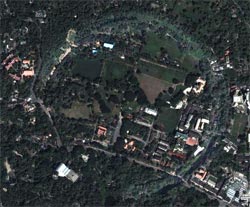
Wiang Chet Rin is a bit less obvious but far more accessible. On google maps it's easily discernible as a big circle north of CMU's reservoir, Ang Kaew, and part of the old moat is even still there. The remains of the wall run through the technical university and Huay Kaew arboretum, where you can walk along it for quite a ways. There's a plaque in front of the moat that says more.
There's a lot more to discover, of course - Wiang Kum Kam is a whole excavated city that's only twenty minutes out of town, and there are plenty of long-forgotten temples hiding in the rice fields. Know of any more? What's your favorite? Let us know at info@www.purechiangmai.com.



